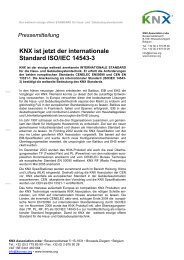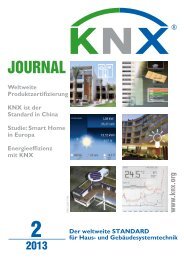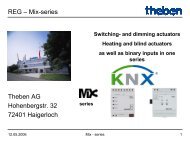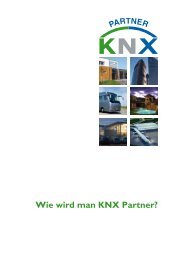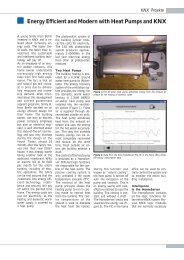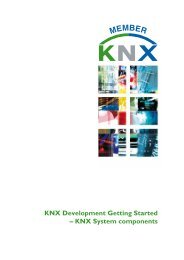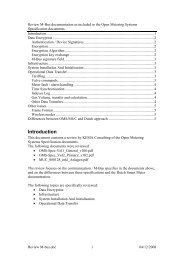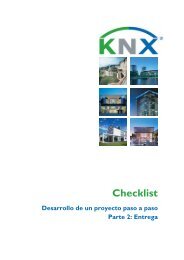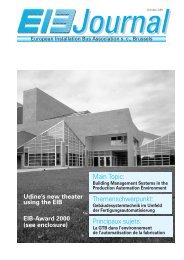KNX Journal 2011-1
KNX Journal 2011-1
KNX Journal 2011-1
You also want an ePaper? Increase the reach of your titles
YUMPU automatically turns print PDFs into web optimized ePapers that Google loves.
Editorial<br />
Automation makes buildings more efficient<br />
Adapt the demand for heating, cooling and lighting<br />
to day-to-day operations with <strong>KNX</strong><br />
In light of climate change<br />
and increasingly scarce resources,<br />
the energy-efficient<br />
operation of buildings is gaining<br />
in importance. Essential<br />
requirements for this are an<br />
energy-efficient architectural<br />
design, an insulated building<br />
exterior and modern installation<br />
engineering with a<br />
high level of efficiency. Ultimately,<br />
the consumption of<br />
energy for lighting, heating<br />
and cooling depends on both<br />
the building use and user<br />
behaviour. These are indefinite<br />
factors for determining<br />
the level of consumption<br />
which can scarcely be met<br />
using conventional methods.<br />
However, with a dynamic<br />
management system, the energy<br />
usage can be optimally<br />
matched to demand during<br />
operation. Building automation<br />
with <strong>KNX</strong> offers the<br />
best preconditions for this. It<br />
ensures the economical use<br />
of energy and thus increases<br />
the energy efficiency of the<br />
building.<br />
Bus devices regulate and<br />
control the generated heating<br />
and cooling capacity in<br />
line with demand. Lighting<br />
installations are operated<br />
more efficiently using sensors<br />
and timer programs. The integrated<br />
automation system<br />
spans all the trades and also<br />
enables links with daylight<br />
systems, sun protection systems,<br />
ventilation flaps and<br />
other systems whereby further<br />
energy-saving potentials<br />
can be exploited. Intelligent<br />
capture of consumption data<br />
(Smart Metering) as well as<br />
coupling with intelligent networks<br />
(Smart Grid) opens up<br />
new possibilities for further<br />
optimisation and increased<br />
energy efficiency both today<br />
and in the future.<br />
Persuasive savings rates<br />
Since the building system<br />
technology is available for the<br />
electrical installation, <strong>KNX</strong><br />
functions guarantee savings<br />
in energy costs for artificial<br />
lighting, heating, air conditioning<br />
and ventilation systems<br />
as well as other loads. With<br />
Energy Savings with <strong>KNX</strong><br />
• up to 40 % with <strong>KNX</strong> shading control<br />
• up to 50 % with <strong>KNX</strong> individual room control<br />
• up to 60 % with <strong>KNX</strong> lighting control<br />
• up to 60 % with <strong>KNX</strong> ventilation control<br />
the further development of<br />
the system which has already<br />
been in existence for 20 years,<br />
the open- and closed-looped<br />
control systems have been<br />
refined and thus increasingly<br />
better results are achieved.<br />
Nowadays, the savings rates<br />
that have been achieved in<br />
practice are up to 60 percent<br />
and more for the lighting<br />
while up to 50 percent is<br />
possible for individual room<br />
control as a practical study<br />
shows. Of course these types<br />
of comparisons assume<br />
a connection to conventional<br />
methods. In the case of renovations<br />
in which the building<br />
has been improved in terms<br />
of its energy efficiency and the<br />
installation engineering has<br />
been modernised, the control<br />
technology contributes to the<br />
efficiency gain by at least 5 to<br />
20 percent.<br />
As often occurs in practice,<br />
if optimisation of the energy<br />
consumption has only been<br />
carried out some time after<br />
the initial occupation of the<br />
building and after experiencing<br />
day-to-day operations,<br />
the concrete results are persuasive.<br />
Rapid amortisation<br />
In the case of at least two<br />
projects, direct investment<br />
costs for optimising the energy<br />
flow are amazingly low<br />
compared to the results. An<br />
amortisation was carried out<br />
immediately. This is linked<br />
to the integrated approach<br />
and multiple use of the sy-<br />
New „SciTec“ Building at Oundle School Peterborough/<br />
Great Britain<br />
Central Control of public Lighting via <strong>KNX</strong> means/<br />
Austria<br />
Thanks to integrated control and regulation via <strong>KNX</strong>, in this project<br />
the following reductions in energy consumption were possible:<br />
• 78 % due to use of natural ventilation<br />
• 50 % due to regulation of underfloor heating in 16 zones<br />
• 60 – 70 % due to constant light regulation and additional presence<br />
sensors<br />
• 40 – 60 % energy saved in total compared to a conventional school<br />
building<br />
The City of Salzburg reduces overall energy consumption for street<br />
lighting by approximately 2,5 % and hence saves 750 tons of CO 2<br />
.<br />
4 <strong>Journal</strong> 1/<strong>2011</strong>




